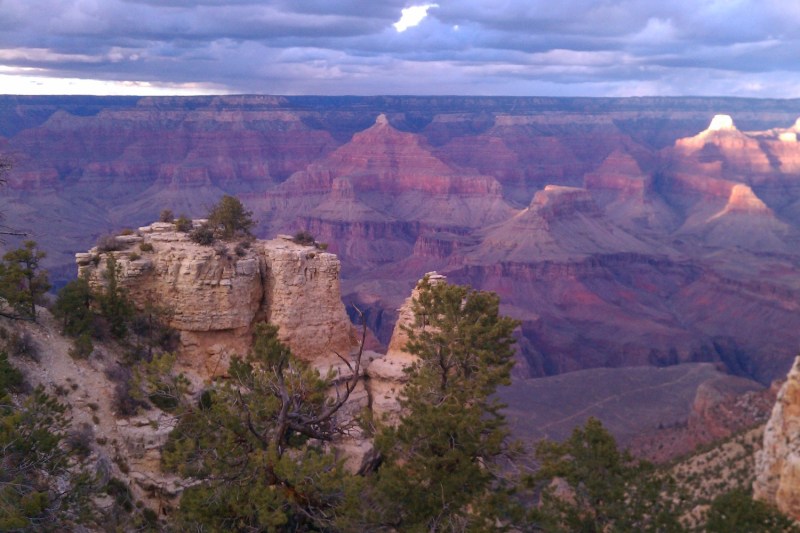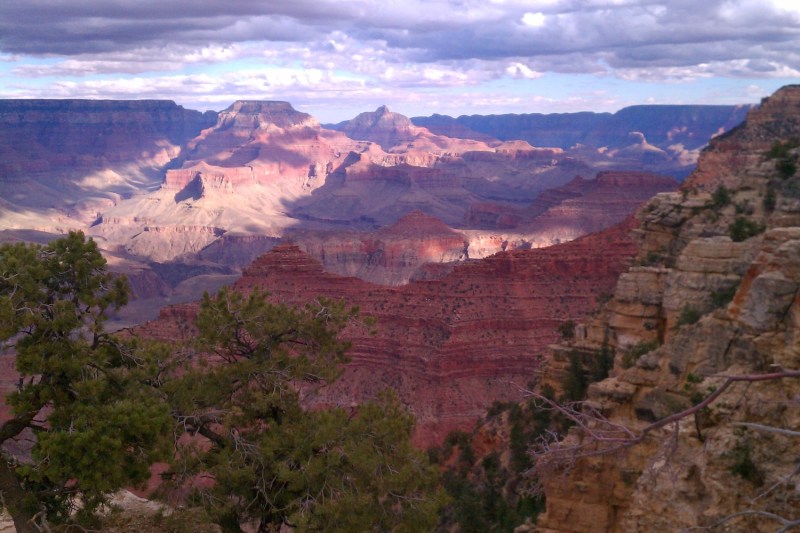The Grand Canyon is one of the world’s most iconic natural wonders. Carved by the Colorado River as it flowed over the deserts of Arizona, the chasm stretches approximately 277 miles in length, up to 18 miles wide, and over a mile deep. The canyon’s layered red rock formations have been a spectacle for generations, and it’s a great trip to have on your bucket list this year. While many might think of the Grand Canyon as a summer destination, that doesn’t quite give the whole picture of what this national park has to offer. Grand Canyon National Park is a year-round destination, and the best time to visit Grand Canyon is really up to your goals and preferences.
What to know before you go to the Grand Canyon

Before deciding when to go, there are a few things that you should keep in mind. There is an entrance fee to enter the park, which is currently $35 per private vehicle. Bring your card, because they do not take cash.
Many of the park’s lodgings require reservations, including hotels along the North and South Rims. Campgrounds in this area such as the Mather Campground (South Rim), Desert View Campground (South Rim), and the North Rim Campground have a very limited number of first-come, first-serve spots available. Reserve in advance for extra peace of mind, and visit the Grand Canyon National Park website for the most current information.
Here’s how to time your Grand Canyon trip

Several factors go into timing your Grand Canyon trip, so it will be up to you to decide when to visit. Here are our thoughts.
Grand Canyon during the fall
Fall is a great time to visit the Grand Canyon due to the cooler temperatures and fewer crowds, but how you experience the season will differ depending on which rim you go to. The South Rim doesn’t have many fall colors, but you will see some if you go to the North Rim. Just be sure to plan your trip before mid-October, because that’s when the North Rim usually closes down for heavy snows.
Until then, fall is a prime time for animal sightings. Look for all kinds of animals, including deer and elk. If you’re a fan of bird watching, look for California condors!
For some North Rim hiking, we recommend the North Kaibab Trail, which is accessible until mid-October. This trail has lush vegetation and a few springs along the way. As for the South Rim, try Ooh Aah Point, which can be accessed through the South Kaibab Trail.
Grand Canyon during the winter
The North Rim is closed during the winter, so if you plan to visit during the chilliest time of year, head to the year-round South Rim. The trails can be icy and snow-covered, so the utmost care is required if you choose to hike. We recommend packing traction devices like microspikes and trekking poles, and you’ll want to ensure you’re in top condition before you attempt any hikes.
Shorter daylight hours in the winter means less time for hiking, so start early and check the Backcountry Information Center for trail updates. Be sure to stay hydrated and bring high-energy snacks when you go.
In terms of hiking trails, Hermit Trail isn’t too bad most winters. You will likely still encounter a little snow and ice, but it will dissipate as you get further into the canyon. You’ll see some spectacular sights along the way, such as the Santa Maria Spring and the Cathedral Stairs. Then about 7 miles in, you’ll hit Hermit Creek Campground and, beyond that, Hermit Rapids.
Grand Canyon during the spring
The weather starts to become milder in the spring, which means that the flowers will start blooming. As the canyon transitions, visitors can enjoy more comfortable hiking conditions and fewer crowds compared to peak season. Don’t forget your rain jacket, because it tends to rain during this season at the South Rim. Spring is also known for windy conditions, so bring a good jacket or wear a merino wool under layer.
The North Rim is generally closed until mid-May, but due to snow, that could extend longer, so check the website for the exact dates.
By this time, however, the hiking trails in the South Rim are all fully accessible. Try the well-maintained Bright Angel Trail, which is a paved, 9.5 miles long one-way that offers jaw-dropping views of the Grand Canyon.
Grand Canyon during the summer
Summer is the busiest time of year for Grand Canyon National Park, so you can expect 2+ hour long lines at the entrance station and shuttle buses, limited parking near the Grand Canyon Visitor Center, and large crowds at popular viewpoints. That said, it all might be worth it if you want to enjoy seasonal activities such as river rafting.
To avoid the crowds, try visiting on a weekday, or in the early hours of the morning. Peak hours are from 10 a.m. to 4 p.m., so that’s when all the hustle and bustle will pick up. You could also just skip the South Rim and head to the North Rim, which opens up in summer. While the North Rim has limited services like dining, lodging, and campground options, it is definitely quieter than the South Rim in the summer.
Daytime temperatures typically range from 80°F to 90°F (27°C to 32°C) in the South Rim, and it can get as high as 115°F (46°C) in the Inner Canyon, near the Colorado River. Because of this, you will be at an increased risk for heat-related complications. Wear sunscreen, stay hydrated, and follow all park guidelines to ensure safety.
No matter the time of year, Grand Canyon National Park has a lot to offer

No matter the season, you’ll experience an unforgettable journey at the Grand Canyon. While the best time to visit the Grand Canyon ultimately depends on your preferences, it’s definitely worth the trip.



